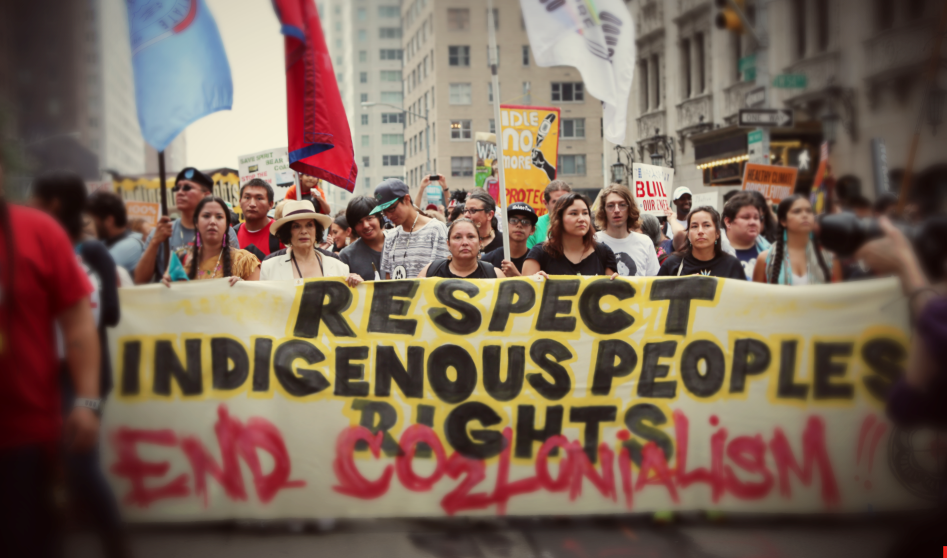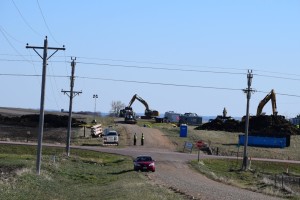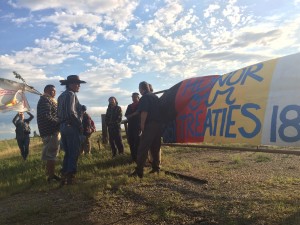Report on Climate Change and the Negotiations for Paris
Alberto Saldamando, Indigenous Environmental Network, November 17, 2015
The Road to Paris:
The Kyoto Protocol uses as a base the States’ emission of GHG in 1990. And the reductions of emissions are measured in tons of GHG and are legally binding. But since the Cancun COP in 2010 another system of reductions has emerged, called, Intended Nationally Determined Contributions (INDC). These contributions are not legally binding. They are only a declaration by each State of the amounts of GHG they are willing (or intend) to reduce. These INDC declarations began at COP 20, Lima.
A 2015 Bulletin of the World Meteorological Organization (WMO) on greenhouse gases reports that between 1990 and 2014 the world experienced an increase of 36% global emissions! The Centre for Science and Environment, cited below, using EPA’s own data, reports an increase of 8% of US GHG emissions since 1990.
The US NDIC propose to reduce their emissions by 26-28% from 2005 to 2025 and 34-37% of 2005 levels by 2030. A report by the Centre for Science and Environment analyzes the Contribution of the United States to reducing GHG. This Indian NGO, using data published by the US EPA, reports that based on 1990 emission levels, the current reduction in the US will be only 13-15% by 2025 and 23-27% by the year 2030. In comparison, the European Union has committed to reduce its emissions to 40% of their 1990 emissions by the year 2030.
Based on their NDIC US per capita emissions by 2030 will be 12.5 – 13 metric tons of GHG, while the per capita emissions in the European Union will be 6.5 metric tons. In addition, the US announced that to reach its goal, it will use carbon sinks (mainly the oceans and forests) and Land Use and Land Use Change (LULUC) to eliminate 250 million tons of emissions, cutting their emissions reduction commitment almost in half. That is, they intend to continue their emissions over and above their NDICs, relying on carbon sinks to absorb 250 million tons of the “excess” GHG.
UNEP, the United Nations Environmental Programme, estimates that the total INDCs that have so far been made are half of what’s required to reach the objective of 2 degrees Celsius by the end of the century, 2100. It hopes, in very optimistic language for more “enhanced ambition” by States in their INDCs in the future.
The Major issues Leading to Paris:
The Kyoto Protocol, (KP) is based on the principle of common but differentiated responsibilities; it imposes a higher obligation to reduce emissions from developed countries because they are historically responsible for the high levels of Green House Gases in the atmosphere. The KP also recognizes that those responsible should pay for adaptation and the transfer of technology needed by developing and under-developed States to adapt and to mitigate global warming. “Loss and Damage” funding for the catastrophic damage caused by climate change not only the past but also the future is also contentious.
Other contentious issues:
- Whether INDCs, such as they are, should be binding. The United States is opposed, saying that if they were mandatory and binding “it would stifle ambitions.” Another theme is the distinction made in Kyoto Protocol between “Developed” and “Developing” States;
- Since emissions from China and some developing countries have reached seriously high levels, they should be treated in the same way as Developed countries. But this implies a rejection of the historical responsibility for climate change and the principle of “equal but differentiated responsibilities.”
The Free Market:
The Clean Development Mechanism of the Kyoto Protocol established carbon credits and carbon offsets. The poison of the atmosphere became a commodity that can be sold on the open market. These carbon credits can be purchased by carbon emitting countries and companies to allow them to continue with their emissions over limitations, whether voluntary or not.
Reducing Emissions from Deforestation and Forest Degradation (REDD) is a program that generates offsets and carbon credits that can be sold on the carbon market. REDD + has received almost universal acceptance among States. Under REDD + investments in forests and reforestation increasing the amounts of carbon sequestered by forests can generate carbon credits for the same amounts of forest carbon increases. These credits can then be sold to States and corporate emitters to meet their emission limits. To paraphrase the Center for Biological Diversity (Comments on CARB White Paper) forest offsets only change the location of emissions – offsets do not reduce them.
Positions of Indigenous Peoples:
The persistent demands of all Indigenous Peoples and indigenous NGOs is that in every action, every project on climate change, States parties recognize, respect and observe the rights of Indigenous Peoples to their lands, territories and resources and be subject to free, prior and informed consent, including the right to say “yes” or “no,” in accordance with the Declaration on the Rights of Indigenous Peoples of the UN (2007) and ILO Convention 169 (1989).
Along with other human rights, women and youth accords:
“This Agreement shall be implemented on the basis of equity and science, in [full] accordance with the principles of equity and common but differentiated responsibilities and respective capabilities[, in the light of national circumstances] [the principles and provisions of the Convention], while ensuring the respect, protection, promotion and fulfillment of human rights, including the rights of indigenous peoples; gender equality and the full and equal participation of women; intergenerational equity; a just transition of the workforce that creates decent work and quality jobs; food security; and the integrity and resilience of natural ecosystems.”
It may not seem like much but it has been and will be a battle. The problem is that the Western States (EU, North America + Japan) do not recognize collective rights as “human rights.” I think we all appreciate that our individual rights are respected. But there is an urgent need for our collective rights to be respected and observed.
On the cessation of emissions there is also a single Indigenous Peoples and NGOs position, that States stop emitting Green House Gases. There is also a consensus opposition to free market carbon offsets and credits. There is also a position on the financing of mitigation and adaptation and REDD projects, that indigenous peoples directly receive funds for the aforestation and reforestation of forests. And I think there’s consensus position that oil and other fossil fuels be left in the ground.
These positions are complicated by REDD and REDD+. REDD is clearly intended to generate carbon credits and offsets for the free market. But some indigenous peoples see REDD as guaranteeing the titling to their lands and territories. Others see REDD projects to be financed directly to the owners of the forests, and that indigenous people will be able to enjoy its benefits without State impositions interference. They have a vision of an Indigenous REDD where all the rights of indigenous peoples are recognized and respected, and their lands and territories recognized and demarcated, with sovereignty and self determination over their lands, territories and resources, under their direct control.
The Great REDD Gamble, a recent report by Friends of the Earth (FoE) pointed to the failures of these aspirations in existing REDD+ projects, finding that REDD worsens tensions around land tenure and access to resources: “as REDD presents governments with an increasing financial incentive for the state to retain or assert ownership.”
“One common factor that emerges very strongly from these case studies is the extraordinarily disruptive influence that REDD+ projects can have on Indigenous Peoples and local communities, especially if people have not consented to the project in question or been engaged in its design, or if there are existing uncertainties about land tenure. We also found that REDD+ projects can trample over existing local knowledge, and interfere with local food security.”
It is the States that define and implement any international accords, and the histories of the implementation of indigenous rights (as well as human rights) does not auger well for an “Indigenous” market REDD. IEN and others do not have any confidence in the States and are totally opposed to REDD based on the free market. Forests must be rescued because they are the lungs of Mother Earth. Financing should be from public funds and not the market, leaving indigenous peoples in peace, free from roads, mono-crop plantations, mineral and fossil fuel extraction and other forms of mega projects, all permissible under REDD. We doubt that a market based REDD will leave indigenous peoples free to care for their forests in their cultural, spiritual and historical role.
Conclusion:
The Stats have been unable to address the problem of greenhouse gas emissions directly and as time passes global warming grows almost exponentially. The negotiations in Paris, to confront climate change in accordance with reality would have to take a very different approach than the one taken since 1992 to date, one based on reality and urgency.
Faced with this failure, given the “solutions” market proposals in the negotiations since 1992 (REDD, intelligent agriculture, LULUC), the forests, lands, territories and resources of indigenous peoples are faced with the threat of land and resource grabs on a massive and global scale.
Indigenous peoples and NGOs hope to be there, in the streets and alleys outside the COP in Paris with other civil society raising our voices. There is still hope in mobilizations. But given the recent tragic terrorist attacks, national and local demonstrations during negotiations may be the only means of providing support and strength to the demand for the “Buen Vivir” of indigenous peoples and the well being of humanity.
—-
Bio Description
This report is provided by Alberto Saldamondo. Alberto Saldamando, (Chicano/Zapoteca) has a BA and JD from the University of Arizona and is admitted to the practice of law California (retired status, Arizona Bar). Mr. Saldamando served as General Counsel to the International Indian Treaty Council (1994-2011) and is presently counsel to the Indigenous Environmental Network on climate change and Indigenous rights issues (2011 – present).
Mr. Saldamando has developed expertise on the Right to Food, and in the United Nation’s mechanisms for the vindication of Indigenous Human Rights and provides representation, training and technical assistance in both Spanish and English to grass-roots Indigenous Communities on international human rights law, standards and practice.




